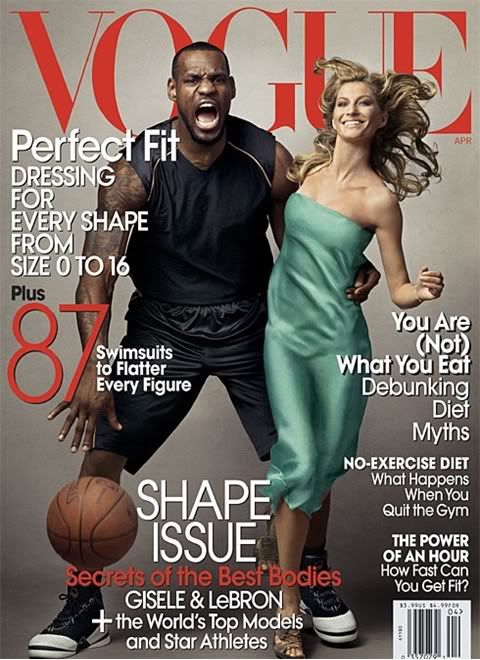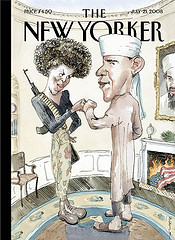Soledad, Solidarity, Sexuality: Black Men and Women In America
Posted in The Gnovis Blog
CNN’s recent in-depth investigative piece, Black in America , explores contemporary race issues, and the various challenges and achievements among blacks in the U.S., presenting a hard-hitting depiction of the frustrations among black
Americans who consistently face prejudice because they are
racialized as black.
The piece covers several core topics around which racial tensions are seen to coalesce, such as the injustice black people often endure within a racially biased judicial system, as well as educational and medical disparities found in many "black" communities compared to "white" communities. Black in America also investigates the underpinnings of the persistent socioeconomic gulf between black and white populations overall, coupled with the simultaneous surge in socioeconomic mobility among many blacks, and the associated intra and interracial complications.
The narrative is driven by one-on-one interviews with black Americans including single professionals, parents in culturally mixed families, and poor as well as affluent black families across a variety of professions. CNN news personality, Soledad O’Brien, uses a very frank style of questioning that I found at many points quite jarring, having been accustomed to the considerable apprehension and discomfort exihibited by media professionals, as they clumsily tip-toe around the highly charged issue of race.
Soledad’s disarming, direct approach and the eye-opening exposition of startling mortality rates, incarceration statistics, and other unsettling demographic data among blacks, give a highly visible platform to show the harsh reality lived by too many black Americans.The result is an extremely personal, often hard-to-swallow depiction of issues and obstacles that people with little exposure to black communities might often blissfully ignore.
The visibility afforded to issues that Americans would prefer to sweep under the ugly race rug is a valuable achievement in and of itself. And CNN’s position as a mainstream news giant grants the reportage an air of objective credibility for the mainstream public than say, an openly activist film produced by Spike Lee or Michael Moore might (that’s not to say this impression is actual).
In addition to faithfully presenting the relevant social justice issues
one might expect in a piece exploring race politics in the U.S., the
structure and the specific topics selected for Black in America, also demonstrate some of the prevalent assertions in dominant American culture regarding race and gender, and their significant intersectionality.
And of course, as complex an issue as race tends to be, I think there is also a deeper subtext to be considered in CNN’s Black in America, particularly in the stories that were omitted.
That CNN chose to structure Black in America as a two part series according to gender, reveals the significance of gender in an individual’s experience of race and racism, also raising unquestioned notions of gender roles, and their effect on conceptualizations of race and construction of racial identity.
Part 1, The Black Woman and Family, presents the experience of single, black women who seek black, male partners, but for various reasons have difficulty finding lasting partnerships with black men. Interracial dating is explored and the experiences of women who choose to date "outside their race."
Part 2, The Black Man, addresses the destructive effects of an unjust judicial system that disproportionately prosecutes and incarcerates black men, and an educational system that sytematically denies blacks equal opportunities for advancement. How these realities impact black communities, black families, and the cultural representation of black men is explored in depth, presenting the stories of men victimized by these circumstances, and success stories detailing how men worked to rise above such obstacles.
The significant differences in the stories presented by black women versus black men, demonstrate how integral gender is to the construction of racial difference within American culture, highlighting how the prejudice individuals face varies greatly between black men and women. However, although the content of CNN’s reporting on black experience may reveal how gender and economics function in the production of race, in other ways, Black in America also reaffirms some mechanisms underlying race-based prejudice in reference to gender.
CNN’s failure to include a broader variety of lifestyles as legitimate, is especially glaring in the case of gender identity, as is the tendency to privilege traditional views of the accepted, hetersoexual family structure, frequently tauting The Family’s central role in promoting order and social advancement.
Marriage rates among blacks, presented in opposition to the considerably higher numbers of whites, are depicted as an accepted, and inherently deterimental reality underlying social and economic stagnation in some black communities. The piece only vaguely touches on underlying root causes, instead focusing quite heavily on promoting personal responsibility among fathers.
Instead, familiies headed by single parents are largely depicted as a
blight within black communities, which has a damning air in its
implications, without examining why or how that damning air is
constructed, beyond statistical associations with increased socioeconomic
instability among single parent families.

Fox News’ recent Lose Weight Exercise of "poor editorial judgment ," describing Michelle Obama using a pop cultural aphorism, used largely in a derogatory manner, in reference to black women.
A different analysis might not
take for granted that heterosexual marriage is the
sole, rightful approach to child-rearing, instead considering the
potential for a familial structure comprised of various extended family
units, which could exist alongside and including the traditionally
sanctioned, nuclear family unit.
Statements from pastors and
other religious officials
who lament their seeming inability to reach community
members with their traditional message, seem to to further edify these
views as those of respected leaders within the black community.
Similarly, highly gendered understandings of the role of males as
breadwinners are also heavily implied if not plainly stated as accepted truth,
as demonstrated in discussing job opportunities only in
reference to men. CNN fails to address potential variations in traditionally established gender roles, ignoring how prevailing conceptions of the legitimate family,
which are based on the white heterosexual ideal, are firmly entrenched in American culture.
CNN fails to critique how these conceptions might be potentially damaging to how
black communities are viewed, positioning a larger percentage of black families as deviant from a proposed mainstream norm.
Culturally established notions of the family and appropriate gender
roles of men and women become futher complicated by, and also reaffirm,
circulating stereotypes of black men and women. These ideas of
how black people do or do not, live up to the ideal gender and familial
roles established in white culture, also factor heavily into the
tensions and controversy of interracial dating.
Speaking (only to black women) about the challenges of interracial dating, straying from one’s race in romance is depicted as a perhaps viable, but clearly less desirable option than partnering with a black man. Exploring this topic grazes the complex intersection of gender, race, and socioeconomic advancement for black men and women. However, these issues are not truly teased out beyond their palid emergence in the statements of various young women.
Failing to examine why such a preference exists among the women demonstrated is problematic. Beyond stating that "some women want a black family and black kids," little is examined about why these women express these sentiments, which may neglect an opportunity to examine how notions of whiteness and blackness, may factor into the determinations of what some black men and women hope to achieve for themselves and their loved ones.
Furthermore, interracial dating, only addressed directly in reference to women, asserting that black men have dated "outside their race" more widely and earlier in history, raises the issue of how gender plays into social constructions of racial identity. But by not developing the validity or the reasons underlying the posited gender differences in dating, CNN may have overlooked a prime opportunity to examine exactly how gender and race bias may relate for black Americans.
In addition, the reality of black individuals who do not subscribe to
these norms in other ways, are completely ignored. Clearly, not all
black indviduals in the U.S. or otherwise, seek a
black partner of the opposing gender, nor do they necessarrily seek
marriage or children either. Yet the ways that race affects the choices
and
lives of such individuals, which are substantially numerous, are not
mentioned at all.
I understand that space and time considerations disallow very deep coverage of all relevant issues. And in trying to reach a broader audience, CNN may be forced to present mainstream views in order to avoid alienating viewers in both black and non-black religious communities. More often than not, this commercial necessity of appeaing to marketing sensibilities, results in excluding what are perceived as queer viewpoints.
But I feel that the complete omission of LGBT individuals, and the overt deference given to the heterosexual marriage unit goes beyond simple editorial decisions, revealing the persistence of traditional views regarding sexuality that pervade American society and western culture.
One example of how gender and racial bias intertwine, which is addressed in the special, is how black men are routinely criminalized by media and law enforcement, made out to be more dangerous than non-black men, as well as black women.

Cover of Vogue, spring 2008 issue
In media representations, black men are too often- whether consciously or unconscously- depicted as threatening to eurocentric norms of beauty, propriety, and sexuality. Many have critiqued Vogue’s decision to depict Lebron James wearing sweats and his decidedly aggressive "game face," in questionable opposition to a dainty, smiling, and elegantly dressed Giselle Bundchen. On some level, the imagery re-establishes, and most certainly trades on the visual allure and conflict rooted in such racialized stereotypes.
These racist conventions and how they are represented in popular culture play a significant role in how prejudice against non-white,
non-heterosexual individuals manifests, establishing such indviduals as
marginal and threatening to the accepted "majority" of what is considered to be the mainstream American
experience. Dependence on this sexual, moral shorthand for propriety and
legitimacy also affects, perhaps most importantly, how non-whites, non-heterosexuals, and other marginalized groups may view themselves.
As demonstrated in the content of Black in America although it is only vaguely addressed, absorbance of racially biased beliefs can significantly affect how one’s story plays out in a society
that systematically denies the legitimacy of groups deemed as other:
those distinguished, however dubiously, as refuting the established norms of white, heterosexual culture.

Cover of The New Yorker, July 21st, 2008
Black in America is a valuable journalistic enterprise, a deep
exploration of racial politics by a mainstream media outlet which is
probably long overdue. But as is probably to be expected, race and
representation of race are very complicated. Race and racialization entail very thorny issues, not the
least of which stem from intersecting and mutually reinforcing norms
regarding gender, class, economics and nationalism. It seems this
tangle results in hazy, semi-enlightened representations, overlooking
many biases that go largely unexamined, but are central to the
depiction, experience, and perpetuation of racist and racialized beliefs prevalent in contemporary American culture.
